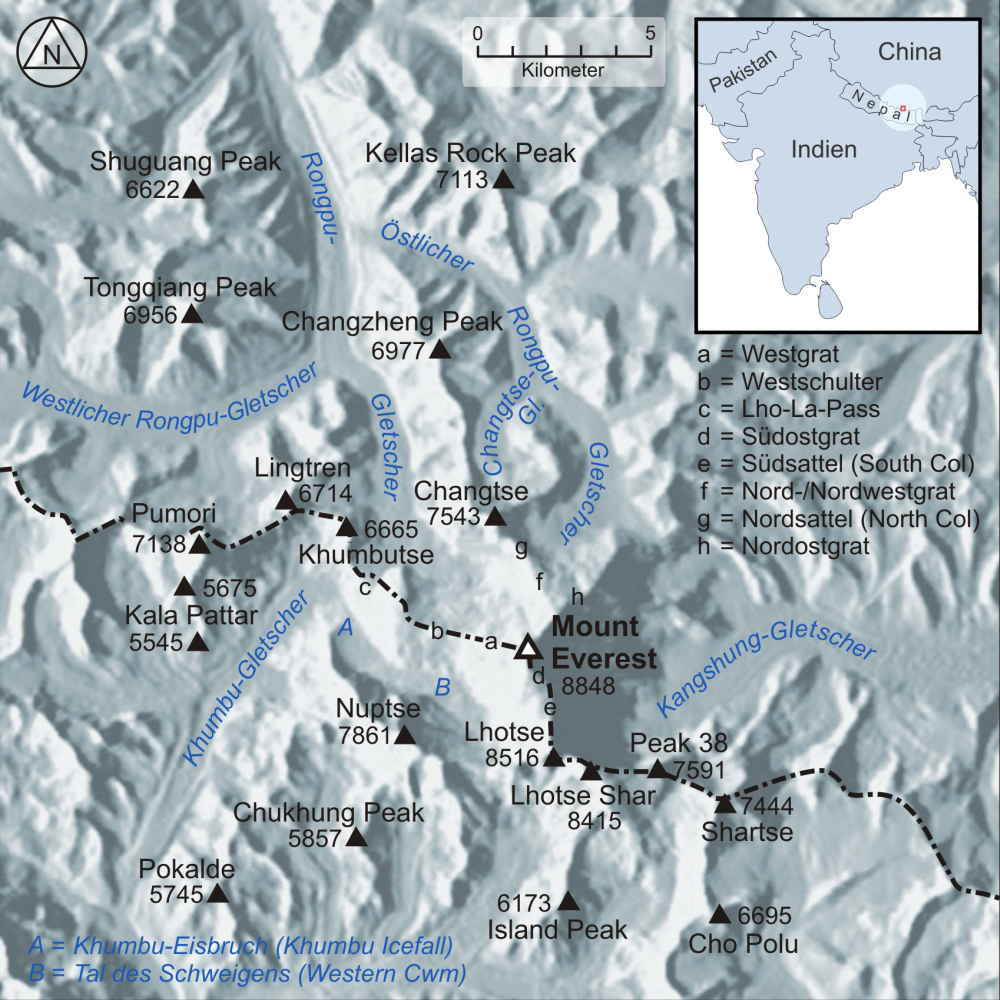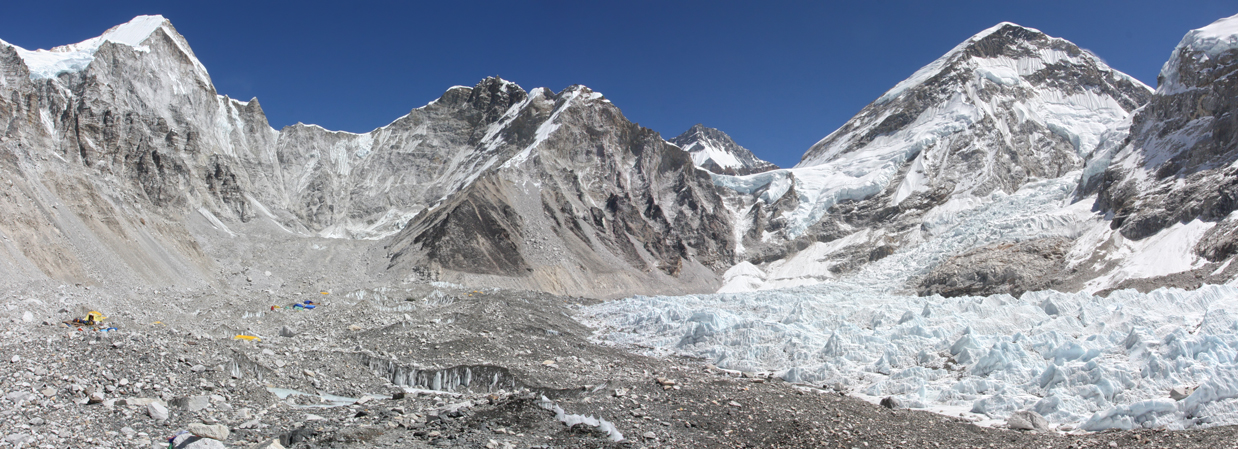Lingtren on:
[Wikipedia]
[Google]
[Amazon]
Lingtren (), , is a mountain in the
 A long chain of mountains extends generally somewhat north of west from Mount Everest whose west ridge descends to the col of Lho La () before rising to Khumbutse (). The ridge drops to an unnamed col at and then ascends to Lingtren from where it continues to another unnamed col at and then to
A long chain of mountains extends generally somewhat north of west from Mount Everest whose west ridge descends to the col of Lho La () before rising to Khumbutse (). The ridge drops to an unnamed col at and then ascends to Lingtren from where it continues to another unnamed col at and then to

Mahalangur Himal
Mahālangūr Himāl (, ''Mahālaṅgūra himāla'') is a section of the Himalayas in northeast Nepal and south-central Tibet of China extending east from the pass Nangpa La between Rolwaling Himal and Cho Oyu, to the Arun River. It includes Mou ...
area of Himalaya
The Himalayas, or Himalaya ( ), is a mountain range in Asia, separating the plains of the Indian subcontinent from the Tibetan Plateau. The range has some of the Earth's highest peaks, including the highest, Mount Everest. More than 100 pea ...
, about distant in a direct line from Mount Everest
Mount Everest (), known locally as Sagarmatha in Nepal and Qomolangma in Tibet, is Earth's highest mountain above sea level. It lies in the Mahalangur Himal sub-range of the Himalayas and marks part of the China–Nepal border at it ...
. It lies on the international border between Nepal
Nepal, officially the Federal Democratic Republic of Nepal, is a landlocked country in South Asia. It is mainly situated in the Himalayas, but also includes parts of the Indo-Gangetic Plain. It borders the Tibet Autonomous Region of China Ch ...
and the Tibet Autonomous Region
The Tibet Autonomous Region (TAR), often shortened to Tibet in English or Xizang in Pinyin, Hanyu Pinyin, is an Autonomous regions of China, autonomous region of the China, People's Republic of China. It was established in 1965 to replace the ...
of China
China, officially the People's Republic of China (PRC), is a country in East Asia. With population of China, a population exceeding 1.4 billion, it is the list of countries by population (United Nations), second-most populous country after ...
and it was first climbed in 1935. A mountain nearby to the west was originally named Lingtrennup but is now more commonly called Xi Lingchain.
Geography
 A long chain of mountains extends generally somewhat north of west from Mount Everest whose west ridge descends to the col of Lho La () before rising to Khumbutse (). The ridge drops to an unnamed col at and then ascends to Lingtren from where it continues to another unnamed col at and then to
A long chain of mountains extends generally somewhat north of west from Mount Everest whose west ridge descends to the col of Lho La () before rising to Khumbutse (). The ridge drops to an unnamed col at and then ascends to Lingtren from where it continues to another unnamed col at and then to Pumori
Pumori (, ) (or Pumo Ri) is a mountain on the Nepal–China border in the Mahalangur section of the Himalayas. Pumori lies just eight kilometres west of Mount Everest. Pumori, meaning "the Mountain Daughter" in Sherpa language, was named by Geor ...
(). Bounded on the north by this chain of mountains is the Western Cwm
The Western Cwm () is a broad, flat, gently undulating glacial valley basin terminating at the foot of the Lhotse Face of Mount Everest. It was named by George Mallory when he saw it in 1921 as part of the British Reconnaissance Expedition that ...
in Nepal down which the Khumbu Glacier
The Khumbu Glacier () is located in the Khumbu region of northeastern Nepal between Mount Everest and the Lhotse- Nuptse ridge. With elevations of at its terminus to at its source, it is the world's highest glacier. The Khumbu Glacier is follo ...
descends to the northwest over the Icefall
An icefall is a portion of certain glaciers characterized by relatively rapid flow and chaotic crevassed surface, caused in part by gravity. The term ''icefall'' is formed by analogy with the word ''waterfall'', which is a similar phenomenon of ...
before it turns sharply southwest. Lingtren lies at the apex of this right-angled bend. North of the mountain chain in Tibet the West Rongbuk Glacier flows east to join the main Rongbuk Glacier. Near Lingtren, the Khumbu glacier is at about whereas the West Rongbuk glacier is at about .
Geologically the south face of the mountain is of black gneiss
Gneiss (pronounced ) is a common and widely distributed type of metamorphic rock. It is formed by high-temperature and high-pressure metamorphic processes acting on formations composed of igneous or sedimentary rocks. This rock is formed under p ...
overlain by a thick sill of massive granite
Granite ( ) is a coarse-grained (phanerite, phaneritic) intrusive rock, intrusive igneous rock composed mostly of quartz, alkali feldspar, and plagioclase. It forms from magma with a high content of silica and alkali metal oxides that slowly coo ...
. The gneiss has been intruded
Intrusive rock is formed when magma penetrates existing rock, crystallizes, and solidifies underground to form ''intrusions'', such as batholiths, dikes, sills, laccoliths, and volcanic necks.Intrusive RocksIntrusive rocks accessdate: March 27 ...
with many thinner granite sills.
The summit elevation is alternatively stated to be and using different elevation models. Lingtren's prominence
In topography, prominence or relative height (also referred to as autonomous height, and shoulder drop in US English, and drop in British English) measures the height of a mountain or hill's summit relative to the lowest contour line encircling ...
is about above its key col, which is between it and its nearest higher neighbour Pumori.
Discovery
Lingtren can easily be seen from inhabited villages in theKhumbu
Khumbu (also known as the Everest Region) is a region of northeastern Nepal on the Nepalese side of Mount Everest. It is part of the Solukhumbu District, which in turn is part of Koshi Pradesh.Bradley, Mayhew; "Trekking in the Nepal Himalaya"; ...
valley of Nepal but it may be that the first time it was seen by western explorers was from Tibet in 1921.
During the 1921 British Mount Everest reconnaissance expedition
The 1921 British Mount Everest reconnaissance expedition set off to explore how it might be possible to get to the vicinity of Mount Everest, to reconnoitre possible routes for ascending the mountain, and – if possible – make the first asce ...
George Mallory
George Herbert Leigh-Mallory (18 June 1886 – 8 or 9 June 1924) was an English Mountaineering, mountaineer who participated in the first three British Mount Everest expeditions from the early to mid-1920s. He and climbing partner An ...
and Guy Bullock were exploring the region to the north of Mount Everest hoping to find a route to the summit. Everest's west ridge did not seem promising so they tried to reach the watershed at some point to see what lay to the south. In doing this they discovered Lingtren (but did not climb it) and skirted its flanks to reach a col from where they were able to see the Western Cwm for the first time. However, the prospect of a precipitous descent to the Khumbu Glacier and then an ascent of the Khumbu Icefall led them to reject this route.
Naming
The peak now known as Lingtren is actually part of a complex formation extending to the north into the West Rongbuk Glacier ''(see 1921 expedition map)''. The northern section, at the junction of the west and main Rongbuk glaciers, is now generally called Guangming Peak () and has an elevation of . The name "Lingtren" now only refers to the highest summit, which is immediately to the north of the Khumbu Glacier. Mallory and Bullock suggested names for the many topographical features they discovered and these were endorsed by the expedition and passed toCharles Bell
Sir Charles Bell (12 November 177428 April 1842) was a Scottish surgeon, anatomist, physiologist, neurologist, artist, and philosophical theologian. He is noted for discovering the difference between sensory nerves and motor nerves in the ...
, Britain's special ambassador to Lhasa
Lhasa, officially the Chengguan District of Lhasa City, is the inner urban district of Lhasa (city), Lhasa City, Tibet Autonomous Region, Southwestern China.
Lhasa is the second most populous urban area on the Tibetan Plateau after Xining ...
, for approval. With reference to the whole Lingtren complex, they chose the name ''Lingtren'' as Tibetan for "subcontinent" or "island". By allusion, this word is also used to describe a lesser temple associated with a main temple.
There is another peak jutting into the West Rongbuk glacier but further to the west which proved to be an excellent location for observing and photographing the mountainous topography. This they named "Lingtrennup" (West Lingtren) and Mallory frequently referred to it by the nickname "Island Peak" because of its isolated location. This mountain has an elevation of and it is now generally called Xi Lingchain ().
First ascent
The 1935 British Mount Everest reconnaissance expedition again explored the region and on this occasion, during whatEric Shipton
Eric Earle Shipton, CBE (1 August 1907 – 28 March 1977), was an English Himalayan mountaineer.
Early years
Shipton was born in Ceylon (now Sri Lanka) in 1907 where his father, a tea planter, died before he was three years old. When he was e ...
called "a veritable orgy of mountain climbing", Shipton and Leslie Vickery "Dan" Bryant climbed for the first time an outlying peak of Lingtren, Lingtrennup and then the main peak of Lingtren. As they were finally descending along a narrow ridge of ice they broke through a cornice and Bryant fell over . Shipton was able to hold the rope and Bryant, who had retained his ice axe, was able to climb back.
Subsequent events
When ascending the Khumbu valley at the start of the successful 1953 Everest expedition, John Hunt said that the glacier appeared as if it could only originate at an apparent valley head between Lingtren andNuptse
Nuptse or Nubtse (Sherpa: नुबचे, Wylie: Nub rtse, ) is a mountain in the Khumbu region of the Mahalangur Himal, in the Nepalese Himalayas. It lies WSW of Mount Everest. The main peak, Nuptse I at an elevation of , was first climbed ...
– the Icefall and Western Cwm were completely invisible around the sharp bend in the glacier. He described one summit of Lingtren as being "square and steep-ridged" and another to the east (he called it Lingtren Two) as "thin as a wafer at its top, looking incredibly fragile".
There has been no fully accepted record of the mountain having been climbed since 1935 and this would mean it has never been climbed from the Nepalese side. This is perhaps remarkable because from Everest Base Camp
There are two Base camp#Shelter, base camps on Mount Everest, on opposite sides of the mountains: #South Base Camp in Nepal, South Base Camp is in Nepal at an altitude of (), while #North Base Camp in Tibet, North Base Camp is in Tibet at ().
...
, along with Pumori and Khumbutse (which have both been climbed), the mountain is very noticeable being less than away. A planned South-African expedition on Lingtren was canceled in 2013. In ''Hoger dan de Dhaulagiri'', claimed he had climbed Lingtren in 1993 saying he started in Nepal and then crossed into Tibet. This claim has, however, been discounted.

References
Further reading
* * * * *External links
{{Mount Everest Mountains of Koshi Province Mountains of Tibet China–Nepal border International mountains of Asia Shigatse Solukhumbu District Himalayas Six-thousanders of the Himalayas